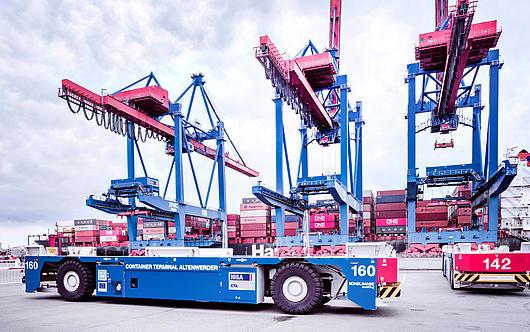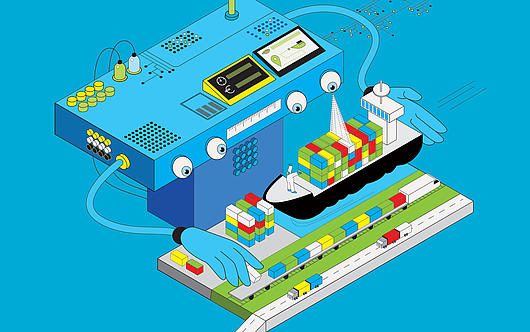
At the small Hermann Barthel shipyard in Derben on the upper river Elbe, a newbuild was launched in early summer with nothing unusual about its appearance. The Elektra keeps its revolutionary propulsion technology hidden out of sight, and yet it could completely transform inland waterway shipping. It is regarded as the world’s first emission-free pusher boat.
The client and project partner is Berliner Hafen- und Lagerhausgesellschaft – or Behala, for short – a Berlin-based port and warehouse logistics company that wants to transport goods in the future between Berlin and Hamburg on barges using the Elektra. This could include heavy generators which will then be loaded onto container mega-ships by HHLA’s floating cranes at the Port of Hamburg. The waterway between the two major cities is just under 400 kilometres long. The pushed convoy will need four to six days to complete the journey, depending on cargo and currents.
Fuel cells and 20 tonnes of rechargeable batteries on board
The launch of the vessel marks a significant milestone: its hull, including the superstructure, is ready and the wheel house is in place. Inside, the air conditioning system has been installed with the required heat pumps, and the fuel cells have been fitted. Next to the fuel cells is a battery room that has been equipped with approximately 250 power storage modules weighing more than 20 tonnes in total.
“The work was largely carried out in very tight spaces and under difficult conditions,” says the shipyard. The biggest challenges were wiring the electrical components, the energy generators and equipment and the monitoring and control systems. From thin data lines to power cables as thick as someone’s arm, almost two kilometres of wiring was laid throughout the ship. The individual units and the entire energy system should soon become operational at the shipyard.
Numerous project partners joined together
The project manager Projektträger Jülich (PTJ) and the National Organisation for Hydrogen and Fuel Cell Technology (NOW) are looking after and coordinating the construction of the Elektra. The pusher boat was developed by the Department of Design and Operation of Maritime Systems at the Technische Universität Berlin. In addition to the Hermann Barthel shipyard and Behala, the project includes the involvement of the companies Ballard Power Systems (for the fuel cells), Anleg (hydrogen tanks), Schiffselektronik Rostock and EST-Floattech (rechargeable batteries). With a total project volume of around € 13 million, the project has received funding of approximately € 8 million from the Federal Ministry of Transport and Digital Infrastructure (BMVI).
In 2022, Behala will begin gradually testing the Elektra and putting it into service. By the end of 2024 at the latest, it will enter scheduled service on the river Elbe. The innovative propulsion idea is now attracting clear attention in the maritime sector. In Hamburg, three new port ferries will also be fitted with fuel cells in the near future based on the Elektra principle. The tendering process is ongoing.
How the technology on board the Elektra works
To operate as a completely emission-free vessel, the propulsion system of the Elektra uses a combination of rechargeable batteries and hydrogen. The electrical energy obtained from these sources powers two rudder propellers manufactured by the German company Schottel. Similar to an outboard motor, they have been flexibly mounted to the stern of the Elektra and provide not just thrust but also optimum manoeuvrability. Each propulsion unit has an output of 200 kilowatts (equating to a total output of around 540 hp). The steering and control system is also provided by Schottel.
The hydrogen for the fuel cells is supplied in six units, each with 20 cylinders stored at a pressure of 500 bars. In total, the Elektra carries 750 kilogrammes of hydrogen on board. It produces electrical energy in the fuel cells by means of a chemical reaction.
However, the weight of the hydrogen is nothing compared to the rechargeable batteries on board: they weigh more than 20 tonnes. By themselves, they provide the vessel with a range of 65 kilometres while pushing 1,400 tonnes of cargo and operating for eight hours. When used in hybrid – in other words a combination of rechargeable batteries and the fuel cells – the range increases to 130 kilometres with an operating time of 16 hours. A fuel station where the batteries can be recharged and the hydrogen reserves replenished is under construction at the Port of Lüneburg on the Elbe Lateral Canal, among other places.


HHLA online magazine: What is so special about the Elektra?
Prof. Gerd Holbach: What’s special about the Elektra is, of course, the new energy system. The Elektra is simply the vessel using this system. Inland waterway shipping is still not completely carbon-neutral. For urban areas is particular, this energy system makes sense, as it is emission-free and ensures noise protection. Incidentally, the idea of using hydrogen as a fuel was developed back in the 1960s. In the freight transport sector, however, the Elektra is a pioneering project. The goal was to demonstrate: it will work!
What about cost-effectiveness?
The investment costs are significantly higher than for comparable conventional pusher boats. However, the goal is to achieve the same cost-effectiveness, in other words with operating costs, as with a diesel propulsion system. But we can factor in other aspects here too: There is potentially an additional benefit that might not seem obvious. The Elektra could serve as an electricity supplier for part of a city, like a mobile power plant – in the context of sector coupling. This comprises heat, energy and mobility.
When can we expect to see a noticeable change in inland waterway shipping?
Looking to the future: with regard to technology, it will be possible to present fully developed solutions in five years’ time. In ten years, this will have a noticeable impact on Europe’s inland shipping waterways. The world in general will become even more hybrid than we can imagine today.







